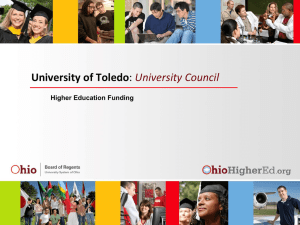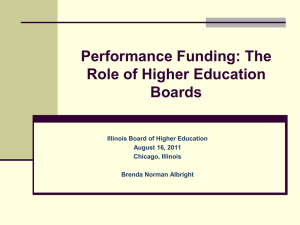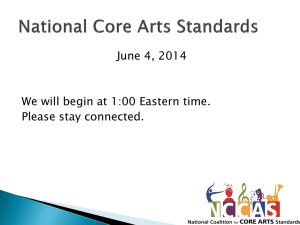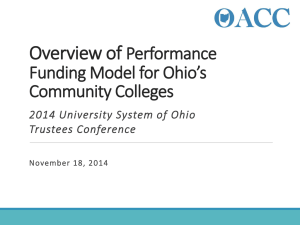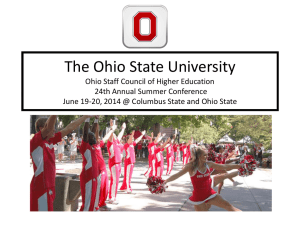Performance Based Funding Formula, David Cannon
advertisement
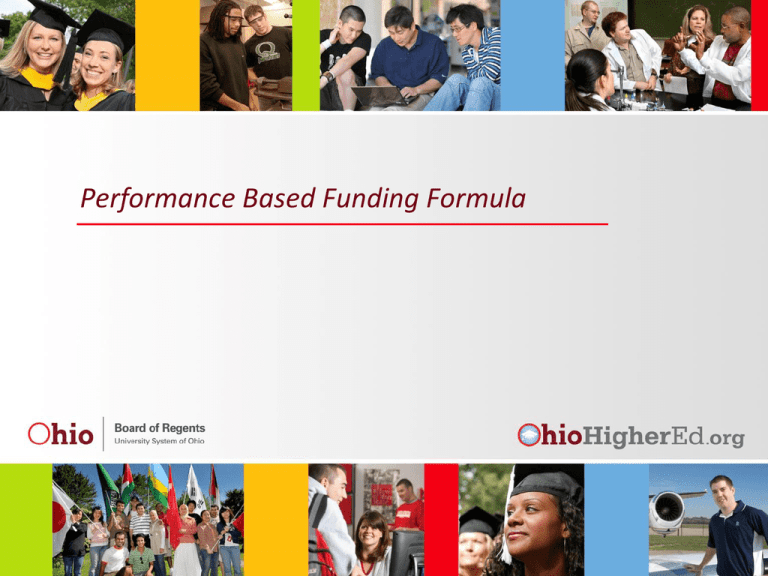
Performance Based Funding Formula Performance Based Funding Formula • SSI History • SSI Overview • University Formula • Performance Changes • OTC Funding Formula 2 Performance Based Funding Formula – Performance Funding Commission Established • Commission of university and community college Presidents formed to guide the process. • Commitment made to simplify the policy drivers in the formula. • Guiding Principles agreed to and distributed early in the process. • Detailed recommendations vetted and voted on by campus CFOs. • Initial goal was to get full agreement on the recommendations from the commission members. • Aspirational goal was to get full agreement from all Presidents. Performance Based Funding Formula – Guiding Principles • Incentivize colleges and universities to improve graduation rates, the number of graduates and time to completion • Raise participation rates in higher education among Ohio high school graduates • Attract best and brightest to learn and work in Ohio • Encourage colleges and universities to attract, prepare and graduate non-traditional and at-risk students • Ensure college is affordable for students and families University Funding Formula • SSI – $1.789 Billion – FY14 - $38.4 Million Increase (2.1%) • $411,247,477 – Community Colleges • $1,372,968,020 – Universities – $116,181,104 – Regional Campuses – $5,474,764 – Bridge Funding/Main and Regional Campuses – $1.821 Billion – FY15 - $32.0 Million Increase (1.8%) • $419,101,428 – Community Colleges • $1,399,124,069 – Universities – Regional Campuses Merged – $3,100,000 – Bridge Funding/Community Colleges – – – – FY10 - $1,706.3 FY11 - $1,710.3 (.20%) FY12 - $1,735.5 (1.5%) FY13 - $1,751.2 (.90%) 5 University Funding Formula • FY2014 • • • • • • For FY 2014, the weighted degree cost component is 50% of the FY 2014 value for the State Share of Instruction for main campuses. Set Asides • Doctoral Set-Aside Allocation = 11.79% • Medical 1 Set-Aside Allocation = 1.48% • Medical 2 Set-Aside Allocation = 6.41% FY 2009 Access Challenge Allocations for Access Institutions (University of Akron, University of Cincinnati, Cleveland State University, Central State University, Shawnee State University, Youngstown State University) The remaining amount is allocated to the course completion component of the formula. Out of State Student Degrees • A weight of 0.25 is applied to out-of state degree costs. • A degree or graduate is considered out of state if the student was reported as non-resident in all terms they attended a public Ohio university. $116.2 Million to Regional Campuses 6 University Funding Formula • FY2014 – Degrees • Bachelor’s, Master’s, and Professional degrees (excepting Medical degrees) awarded at university main campuses • STEM weighting for degrees • Associate degrees awarded at main campuses that received Access Challenge funding in FY2009. – FY14 Associate Degree Earnings - $9,462,815 » Akron - $4,287,680 » UC - $1,011,156 » Shawnee St - $2,446,368 » Youngstown St - $1,717,611 – Access Challenge - $3,923,764 • Kept in formula through FY15 • Was supposed to be removed in FY16 but looking at phasing out in next biennium 7 University Funding Formula • FY2014 – Plant, Operation, Maintenance (POM) • Removed in FY16 • UT $811,326/Central State $1,619,418 – Stop loss • Removed Stop Loss • One year Bridge Funding for universities that would receive less than 96% of FY2013 funding – Three year average for all data in formula – Doctoral – $161.7 Million • 62.5%/55% - Share of FTE • 25%/30% - Share of Degrees • 12.5%/15% - Share of Research Grant Activity – Medical - $108.3 Million • Med I - $20.3 - OSU – Veterinary/Dental • Med II - $88.0 Million 8 University Funding Formula • Distribution of University SSI for FY14 – $1,256.8 Billion/$1,372.9 Billion – 28.2% Course Completions - $354.4 Million/$470.6 Million (34.3%) • At-Risk Factors • STEM weighting – 50% Degree Attainment - $628.4 Million/45.8% when UB Added • At-Risk Factors • Added STEM weighting for degrees • STEM weight for degree matches STEM weight for courses – 21.5% Doctoral/Medical – $270.1 Million/19.7% when UB Added • Percentage based so increase with additional appropriations • Remove Quality Measures and include in Historical component 9 University Funding Formula • Revised Distribution of SSI for FY15 – 50% Degree Attainment • Risk Factors student based – Based on graduation rate of a particular category of at-risk students compared to the graduation rate of students with no risk factors, leading to 15 individual at-risk weights • STEM weighting – 30% Course Completions • Risk Factors • STEM weighting – Remove separate funding for regional campuses • Regional campus students included in university performance metrics • Emphasis on graduation 10 University Funding Formula • Case Risk Factors student based 00: No risk factor 01: Financial only 02: Academic Only 03: Financial and Academic only 04: Age only 05: Age and Financial only 06: Age and Academic only 07: Age, Financial and Academic only 08: Race only 09: Race and Financial only 10: Race and Academic only 11: Race, Financial and Academic only 12: Race and Age only 13. Race, Age and Financial only 14: Race, Age and Academic only 15: All risk factors 11 University Funding Formula case case case case case case case case case case case case case case case case case 00 01 02 03 04 05 06 07 08 09 10 11 12 13 14 15 any risk Students 64,983 34,352 12,780 9,480 853 974 342 870 4,027 5,397 1,788 7,224 99 576 41 551 144,337 79,354 Graduates 47,530 23,201 6,478 3,837 141 232 81 208 2,144 2,638 657 1,952 16 44 6 83 89,248 41,718 State Grad Rate 73% 68% 51% 40% 17% 24% 24% 24% 53% 49% 37% 27% 16% 8% 15% 15% 62% 53% Weight 8.3% 44.3% 80.7% 342.5% 207.1% 208.8% 205.9% 37.4% 49.6% 99.1% 170.7% 352.6% 857.5% 399.8% 385.6% 18.3% 39.1% 12 University Funding Formula • Revised Distribution of SSI for FY15 • All Universities eligible for Associate Degrees awarded at All Campuses • Previously only eligible if awarded by main campus of Access Challenge funding schools • Stackable degrees • Proportional degree funding • Splits degree funding based on cost of courses at IUC Institutions • Bonus of cost of degree from outside IUC to degree granting institution • Degree funding awarded to universities for out-of-state students remaining in Ohio to work or continue education • Weighted at 0.5 IF the graduate remains in Ohio • Must be employed or enrolled in a USO school • Will use a rate so as not to delay funding of these degrees 13 University Funding Formula – Proportional Degree Funding – Degree costs divided amongst IUC institutions based on courses taken at each IUC institution – “Bonus” to degree granting institution if total degree costs are less than statewide average cost for that degree • Typically when there are transfer in credits from outside the USO, exam based credits … • If it is the student’s first degree at that level • Bonus credits are not included in the at-risk add-on – Degree selection will need to be done at OBR 14 University Funding Formula • Revised Distribution of SSI for FY15 AKRON BOWLING GREEN CINCINNATI • Out of State degree earnings based on degree cost and percentage of students who stay in state (stay in state rate) CLEVELAND STATE CENTRAL STATE KENT STATE MIAMI NEOUCOM OHIO STATE OHIO UNIV SHAWNEE ST. TOLEDO WRIGHT ST. YOUNGSTOWN ST. 29.630% 18.343% 18.721% 28.889% 19.663% 20.200% 7.372% 25.000% 14.182% 9.509% 5.263% 28.125% 13.095% 18.699% 15 University Funding Formula 16 University Funding Formula 17 University Funding Formula 18 University Funding Formula 19 University Funding Formula OTC Funding Formula • SECTION 363.120. POST-SECONDARY ADULT CAREERTECHNICAL EDUCATION The foregoing appropriation item 235444, Post-Secondary Adult CareerTechnical Education, shall be used by the Chancellor of the Board of Regents, in consultation with the Superintendent of Public Instruction and the Governor's Office of Workforce Transformation, to support post-secondary adult careertechnical education. The Chancellor of the Board of Regents, the Superintendent of Public Instruction, and the Governor's Office of Workforce Transformation, or their designees, shall hold a series of consultations with the Ohio Technical Centers during fiscal year 2014 to develop an appropriate funding formula to distribute these funds based on student outcomes, beginning in fiscal year 2015. 21 OTC Funding Formula • In FY 2015, the State of Ohio appropriation for the Ohio Technical Centers is $15,817,547. • $400,000 is to be distributed to the Ohio Central School System; • $48,000 will be used for accreditation assistance for Ohio Technical Centers; and, • $975,000 shall be distributed to the 39 Ohio Technical Centers that provide business consultation with matching local dollars. Centers meeting this requirement will receive an amount not to exceed $25,000 per center. • The OTC Performance Funding Consultation Group proposed the remainder be disbursed through a performance-based formula in FY 2015 calculated with a three-year average and based on a fulltime equivalent of 450 clock hours on four major performance metrics - retention, completion, credential, employment. 22 OTC Funding Formula • • • • Retention – 20% shall be distributed based each Center’s full-time equivalent students who complete 50 % of an approved program of study as a measure of student retention. Completion – 25% shall be distributed based on each Center’s full-time equivalent students who successfully complete a post-secondary workforce training program approved by the Chancellor with a grade of C or better or grade of pass if pass/fail basis. Credential – 5% shall be distributed based on the proportion of each Center’s full-time equivalent students to the total full-time equivalent students who have earned a credential from an industry recognized third party. Employment – 50% shall be distributed based on each Center’s fulltime equivalent students who have found employment, military service or additional post-secondary education and training. The calculation for eligible full-time equivalent students shall be based on students who have completed at least 50 percent of a program of study. 23 THANK YOU

